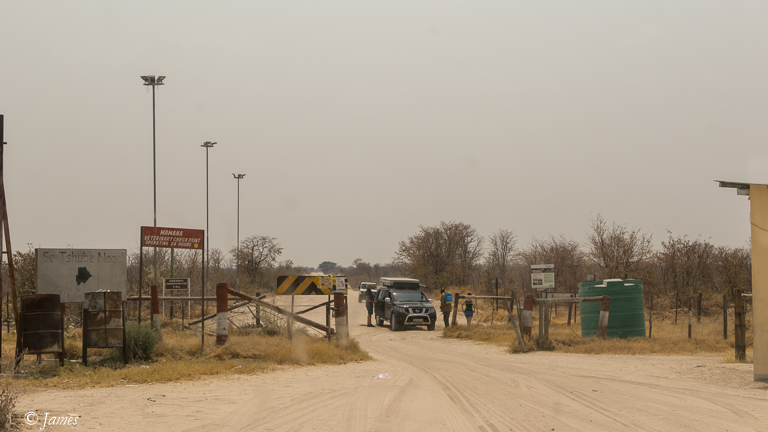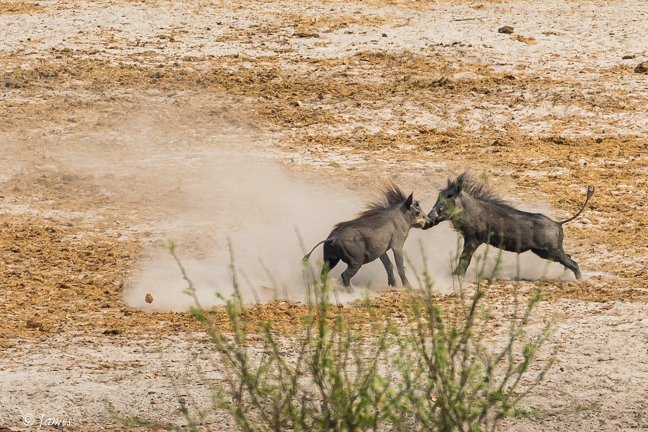Ailine & David departed for Motswiri by light plane. I wonder how they went with the bag limits – I’m also concerned, but we have paid extra.
I waited till 10.30 for the Tuskers 4×4 to arrive, having also asked the agent in Cape Town to contact them to ensure they were coming. The drive is tar for about 30 mins, but is then a wide, bumpy sand road. The driver kept asking if I was OK! We crossed the buffalo fence after another 30 mins, turned right to follow it for the last 30 along a track. The camp is remote, in the dry Mopani ‘forest’. Only eight tents, the dining, lounge, and drinks tents placed strategically for the view. Water is scarce, so animals are sparse at this time, however the camp feeds saline bore water into a water hole 150m from the camp, from which I watched a large herd of elephant in the afternoon heat. I was offered lunch but refused as it was so hot. I asked if there were other guests, but had an equivocal reply from the manager who briefed me. It seems there is a couple coming from the Xobega camp (where I go next), as well as some on an all day trip – whew!
My tent is similar to that in the Mara; I also have to be escorted to it at night. It has saline cold water for a shower and toilet, and a bucket is filled at night with hot water for a shower. 12v power so lights are dim. And its hot.
I spent 4hrs alone at the tents watching the animals come and go to the waterhole, so I had 700 images, reduced now to 20.The smallest elephant has taken exception to the warthogs that circle the muddy pan several times. He chases them continually, but they did eventually get to drink and wade in the mud to cool off. They then scrape the mud off on low stumps. A few kudu arrived and left, and a pair of ostriches, and the tiny steenbok. Impala are common. Many birds are located here: a yellow bill hornbill, and several beautiful crimson breasted bulbul have taken residence. On the way here we saw the largest flying bird – the kori bustard and sand grouse that spend most time on the ground, but they fly to water in the morning, so is a way for humans to find water too.
Yellow-billed hornbills, a common and widespread resident of dry thorn veldt and broad-leafed woodlands feed mainly on the ground, where they forage for seeds, small insects, spiders and scorpions. The hornbill name is derived from the shape of the bill, “buceros” being “cow horn” in Greek. The eyes are protected by large eyelashes which may act as a sunshade.
Tuskers is named for an obvious reason – elephant abounds here. The area is dry sclerophyll forest dominated by Mopani scrub, with occasional larger trees. Elephant damage is huge, perhaps too much, but this does lead to opening the forest to allow grass to flourish (as can be seen between the two buffalo fence lines) which brings the browsers, followed by the cats.
Close by the camp is the elephant grave yard; a large area of many skulls of those hunted in days past from this hunting camp. Not a pretty site. Also the horns of antelope which have been bored by a moth larvae that results in a ‘ringlet’.
The afternoon drive was largely birds; the nests of buffalo weaver hang mostly on the west side of trees for protection from the hot east wind. I thought I could smell the strong acid scent of Matabele ants. Termite mounds are frequent. The only green in this grey world are the shepherd trees that have deep roots to water. The roots can be eaten, and the tree provides shade for herders.
I shared anecdotes with a Chinese group from Brisbane, and an older USA woman with her young, Ecuador guide, now living in SA. They say my next camp is even more basic.
After downloading the images from today, and a warm bucket shower, I fell asleep to the sweet sound of the night jar and other calls.
In the early 1970’s the European Union stipulated that Botswana had to control the movement of wildlife into its beef herds in order to control diseases such as foot and mouth from infecting the cattle. As beef was the country’s largest export at the time the government of Botswana embarked on a policy of erecting fences in strategic places across the country.
Most of these fences were erected without a feasibility study being carried out with the result that the migration routes of a number of species have been cut off and tens of thousands of animals have died in the past two decades from the denial of a route to water and new grazing. A wildebeest migration second in size to the great migration of east Africa happened between the central regions of Botswana and the waterways of the north. During times of drought more than half a million animals would head north to the Okavango and Savuti. One of the first fences to be erected was the Khuke Fence on the northern boundary of the Central Kalahari Game Reserve. What this fence did was to stop this huge migration of wildebeest – with the result that the wildebeest population in Botswana has dropped more than 90 percent.
Possibly the best known fence is the ‘Buffalo Fence’ built in 1995 that separates Maun from the Okavango Delta. It is also called the Veterinary Fence or the Setata Fence. It literally stretches across the breadth of the country. There was a huge outcry when the fence was erected. Accordingly, the fence was removed in 2004, and rebuilt in 2008 with provisions that substantially mitigate the adverse affect on wildlife. It has since been acknowledged by many that the fence may have saved the Okavango Delta. At about the same time as the erection of the fence, the Botswana government had embarked on a project to wipe out the Tsetse fly from the delta. The Tsetse fly was the very reason that cattle had not moved into the prime grazing lands of the Okavango floodplains. Sleeping sickness and Nagana were prevalent in Botswana at the time and with the Tsetse fly gone it would be a free for all for cattle in the delta. The fence stopped that before it could happen.

Island Safari Lodge 
Buffalo Fence 
My tent 
The Camp Viewing 
Kori Bustard 
Crimson breasted bulbull 


Yellow bill hornbill 
















Sounds stiflingly hot. Don’t think I could bear that. But the wildlife calls would be nice to fall asleep to again… I assume that the elephant hunting is no longer? I hope so.
No hunting now but the elephants are clearing the bush. Ot sure its all good